#ableton note
Explore tagged Tumblr posts
Audio
comin out this Christmas! My most experimental project! All beats were made on my phone using ableton note
0 notes
Text
⋯ electronic music themed id pack !!

names ⁘
byte ☆ rave ☆ dj ☆ melody ☆ cadence ☆ galaxy ☆ gamma ☆ ableton* ☆ logic* ☆ launch* ☆ neon ☆ lyric ☆ akai* ☆ glimmer ☆ synth ☆ crystal** ☆ remix ☆ ultra ☆ tech ☆ glitch ☆ cyber ☆ g** ☆ fader* ☆ velocity ☆ lumen ☆ decibel ☆ radio ☆ treble ☆ plasma ☆ nektar* ☆ metronome
* relating to music production ** relating to musicians/songs

pronouns ⁘
lyr/lyric ☆ dub/dubstep ☆ note/notes ☆ bass/bass ☆ glow/glows ☆ ne/on ☆ bright/brights ☆ shine/shines ☆ sound/sounds ☆ 4/4

titles ⁘
The Rave (Mom/Dad/Parent) ☆ (prn) Who Dances Under Stars ☆ One With the Bass ☆ (prn) Who Moves With the Music ☆ The Headliner ☆ The Painter of Sound

system names ⁘
The Music Festival ☆ Radio Waves ☆ Harmony of Lights ☆ The Mixtape ☆ The Synthesized Stars

Even as an EDM producer this was hard, but super fun. I just could not think of as many as I wanted... I hope y'all enjoy either way! -Zoa (she/her)
credits: 1 • 2(trying to find post, reformatted)
#cosmozoa— id pack#id pack#npt#system names#name ideas#endo friendly#pronoun suggestions#name suggestions#mogai friendly#neopronouns#id packs#name list#pronoun list#titles#nonbinary names#gender neutral names#pronoun ideas#cosmozoa— id pack 🌌
102 notes
·
View notes
Note
how do u find all ur samples!? how do u write music so fast its literally called speedcore!? do u click with your mouse in a MIDI synthesizer!?!?!?!?!? its a rlly cool genre but not only do i hage... uh.. like no musical exp... but i also have no idea where people get all their samples.
Ive downloaded polyphone already so i can just Make soundfonts once i have enough samples
I find a lot of samples either by friends sharing them/recommending them or by searching "(genre) sample pack" online and pirating the ones that cost money (if there's a torrent available) or just downloading all the free ones. I honestly haven't gotten new samples in a while so I don't have the best tips >_< but this should get you Somewhere, at least. Sometimes artists I like also put out sample packs and I like getting those when I can! Fun to play with!
If you just mean samples as in other music or funny bits I have sampled in my music, I don't really have specific advice for finding those, I just tend to sample things I like the sound of or things that make me laugh (like all the meme samples I have sprinkled in my music)
As for writing music/speedcore... I can't tell you everything because I'm not really a great teacher/I'm bad at explaining things, but I can try to explain some basics?
Speedcore is typically classified as 300+ BPM, but I honestly never really make my tracks more than 260BPM. I compensate by doubling or quadrupling or whatever-ing my notes constantly, like so:

When I make kickpatterns I tend to go "in between the lines" where the notes are so small/fast that many of them can fit in between two lines of the grid... like how there are 4 in one cell below. Ableton has a really neat tool for this (as well as other handy MIDI manipulation tools) that allows you to chop a note into as many parts as you want very quickly, (but as you can see when zoomed in I did this by hand because I hadn't found out about that feature yet >_>)
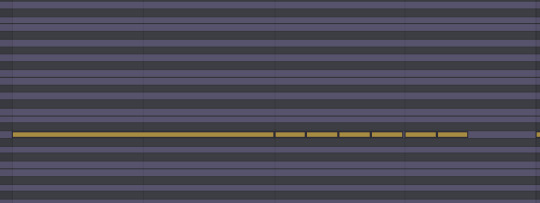
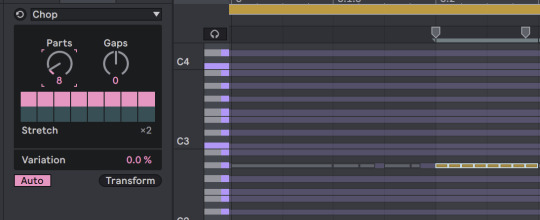
But yeah, a big part of speedcore is the kick pattern(s). It can be as crazy or as uniform as you like, I tend to go either way, just as long as it sounds good to me :) For general structure, try listening to other speedcore artists and really listen closely for variations in the pattern.
Other parts I typically like to include in any speedcore-esque thing I make is a breakbeat/amen break, usually some sort of melody(? is that the right word), any additional percussion, and, optionally, whatever sample(s) you want to include.
Obviously this isn't all there is to it... you still need general knowledge of whatever software you're working in, which is best learned by just sitting down and watching a long, boring tutorial (try to pause and follow along/copy what they're doing, because just watching it and not trying it is like... information just goes in one ear and out the other without you actually understanding it... at least in my experience). It sounds pretty painful, I know, and figuring it out all on your own IS an option, but you might be a lot less frustrated if you just sit down & take the time to listen & learn...
There are also tutorials/guides for specific genres out there, and I'm very sure there are probably some helpful speedcore ones that go into way more detail than I did here.
I have a WIP page on my website that talks a bit about music-making, but again it's very WIP and there's a lot of information missing...it might be a little helpful though
If you have any other questions feel free to ask, I tried to keep this short but kinda failed and I feel like I'm definitely forgetting a lot of things anyway... >_>
12 notes
·
View notes
Note
Hi! Your music is so good, I love Breakcore Burnout, Popping Up Everywhere, and Multicoloured Helium-Filled Nightmare Zone sm X3 How did you get started making music if you don’t mind me asking? What programs/instruments do you need to start making electronic music?
you literally dont need anything except for a computer to make electronic music. if you already know how to play piano or a different instrument, getting a synthesizer could be really useful to you but it is by no means essential. even though i own a bunch of synthesizers and electronic instruments and effects, the bulk of my musical output has been made 100% on the computer and i rarely use my physical equipment outside of playing shows.
but really it depends on what excites you-- and what headaches you're willing to deal with. no process is perfect, and every way of making music has pain points, has aspects to it that are work and not creative expression. for me, using physical instruments is a LOT more fun, but the headache comes from setting everything up and breaking everything down every time. being in my bedroom when i lived with my parents and now living in a studio apartment i share with my wife, space has been an issue in every place ive lived. making music in one little box is the most effective way for me to do it and also the easiest way for me to hone in on the specifics i want.
when you make music with physical instruments, you are limited by the parameters you are given. once you run out of effects to plug something into or ways to automate something-- you're done. theres nothing else you can do to change the sound. on the computer you are only limited by your CPU for how many effects and routing points you can use. so even though its much less exciting for me to make music in the DAW, the freedom it allows me is ultimately much more rewarding. but i know other people specifically DONT like that, and like the limitations of working with gear because it forces you to not get bogged down in the details. i don't know what your musical background is so i honestly can't reccomend one way or the other. neither is inherently better. BUT making music on the computer IS inerently cheaper.
i got started with a demo of FL studio in like 2011 and bought a license a few years later. There are a ton of different programs people use to make electronic music though and they are called DAWs or Digital Audio Workstation. Some of the most popular are Ableton, FL Studio, and Logic Pro. there are some free or cheap alternatives though like Reaper or Cakewalk that i know people like. Most DAW's will come loaded with a ton of synth and effect plugins so you can start making music right out the gate. There also exist a lot of free plugins out there on the internet. I mostly use stock and freeware plugins myself!
If you specifically are interested in making breakcore. There is a second type of program you should also consider looking into called a Tracker. you can find free ones online. I like Milkytracker myself. but a license for Renoise is also pretty cheap as far as a music production suite goes, its much less of an investment than a license for a DAW. they work VERY differently, but they are what traditionally has been used to make jungle and IDM music since the 90s. Instead of the skeuomorphism of a piano roll you'd get in a DAW, you are kind of just given a spreadsheet to fill out data in. in each field you write down note values, what instrument you want to trigger, and effects parameters. it sounds complicated at first, and definitely LOOKS complicated at first too- but once you get the hang of it its actually not hard to read and it allows you to make very complicated breakbeat chops or re-stutters or whatever very quickly.
anyways, hope any of this helps! you are going to have to do some googling and digging around youtube to figure out what's right for you. good luck!
11 notes
·
View notes
Text

Who do you trust most with the aux? Myself… or my twin sister Ellie. What’s a song that reminds you of your hometown? “Scatterbrain” by Radiohead I would listen to this on my iPod on repeat. Who is Pivot & Scrape for? Anyone who would like to listen. I don’t like the idea of having a target audience. What led to your pivot to music? I’ve been making music since I was 14 just by myself. My mom was a piano teacher and I grew up taking voice lessons since I was 9. I started off writing melodies with my omnichord then started using Ableton and experimenting with different sounds and textures. What makes an iconic bang? A nostalgic melody. Who are your style icons? Zoe Lund, Beatrice Dalle, Nina Hagen, Lizzy Mercier Decloux, Nastassja Kinski, Anais Nin, the list goes on and on. So many iconic, stylish, and outlandish women out there. Who is your muse? Stina Nordenstam and Kazu Makino. Name your favorite artist no one knows about: Grim. Jun Konagaya is a legend and I try to show everyone I know his music. It’s truly magical and from another time. You can find him on YouTube. His solo ambient/experimental work is amazing too. What does your notes app look like? Lyrics that don’t make any sense, me constructing texts to bail on people (I’m very good at that), breakup texts, if you really scroll far back. Basically, any social interaction that gives me anxiety is in there. Hot Girl Summer or Sad Girl Fall? Funky Monkey Fall. What was your coming-of-age soundtrack? Anything Elliott Smith. I grew up on his music and listened to him every day for about ten years when I was in school. He got me through a lot of times when I felt like a total loner in school. What was on the moodboard for the “Black and Blue” music video? The canoe scenes from Celine and Julie Go Boating were my biggest influence. I’m a huge fan of Rivette and Berto and anything they do together. The stop motion Wolf House was another huge inspiration on Ellie’s behalf. What album is playing in heaven? Dark Island by Pram. Best movie-needle drop: “Spoon by Can” in Morvern Caller. Hands down best movie soundtrack. Favorite song to listen to while lying on the floor? “Trains Across the Sea” by Silver Jews What’s your go-to karaoke song? Anything Carpenters or Pulp. If I’m feeling risqué, I’ll sing something from Cabaret.
Actress-Turned-Musician Sophie Thatcher Endorses Funky Monkey Fall | Sound Advice | Interview
spotify playlist made by sophie
22 notes
·
View notes
Text
Music Theory notes (for science bitches) part 3: what if. there were more notes. what if they were friends.
Hello again, welcome back to this series where I try and teach myself music from first principles! I've been making lots of progress on zhonghu in the meantime, but a lot of it is mechanical/technical stuff about like... how you hold the instrument, recognising pitches
In the first part I broke down the basic ideas of tonal music and ways you might go about tuning it in the 12-tone system, particularly its 'equal temperament' variant [12TET]. The second part was a brief survey of the scales and tuning systems used in a selection of music systems around the world, from klezmer to gamelan - many of them compatible with 12TET, but not all.
So, as we said in the first article, a scale might be your 'palette' - the set of notes you use to build music. But a palette is not a picture. And hell, in painting, colour implies structure: relationships of value, saturation, hue, texture and so on which create contrast and therefore meaning.
So let's start trying to understand how notes can sit side by side and create meaning - sequentially in time, or simultaneously as chords! But there are still many foundations to lay. Still, I have a go at composing something at the end of this post! Something very basic, but something.
Anatomy of a chord
I discussed this very briefly in the first post, but a chord is when you play two or more notes at the same time. A lot of types of tonal musical will create a progression of chords over the course of a song, either on a single instrument or by harmonising multiple instruments in an ensemble. Since any or all of the individual notes in a chord can change, there's an enormous variety of possible ways to go from one chord to another.

But we're getting ahead of ourselves. First of all I wanna take a look at what a chord actually is. Look, pretty picture! Read on to see what it means ;)
So here is a C Minor chord, consisting of C, D# and G, played by a simulated string quartet:
(In this post there's gonna be sound clips. These are generated using Ableton, but nothing I talk about should be specific to any one DAW [Digital Audio Workstation]. Ardour appears to be the most popular open source DAW, though I've not used it. Audacity is an excellent open source audio editor.)

Above, I've plotted the frequency spectrum of this chord (the Fourier transform) calculated by Audacity. The volume is in decibels, which is a logarithmic scale of energy in a wave. So this is essentially a linear-log plot.
OK, hard to tell what's going on in there right? The left three tall spikes are the fundamental frequencies of C4 (262Hz), D♯4 (310Hz), and G4 (393Hz). Then, we have a series of overtones of each note, layered on top of each other. It's obviously hard to tell which overtone 'belongs to' which note. Some of the voices may in fact share overtones! But we can look at the spectra of the indivudal notes to compare. Here's the C4 on its own. (Oddly, Ableton considered this a C3, not a C4. as far as I can tell the usual convention is that C4 is 261.626Hz, so I think C4 is 'correct'.)
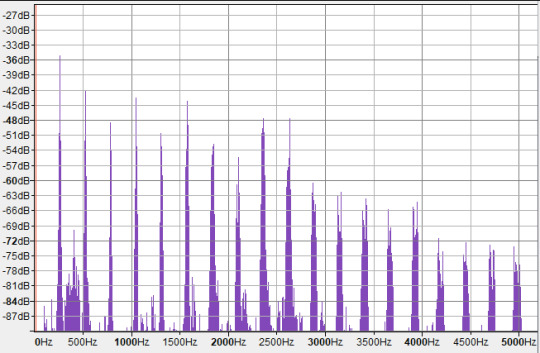
Here, the strongest peaks are all at integer multiples of the fundamental frequency, so they look evenly spaced in linear frequency-space. These are not all C. The first overtone is an octave above (C5), then we have three times the frequency of C4 - which means it's 1.5 times the frequency of C5, i.e. a perfect fifth above it! This makes it a G. So our first two overtones are in fact the octave and the fifth (plus an octave). Then we get another C (C6), then in the next octave we have frequencies pretty close to E6, G6 and A♯6 - respectively, intervals of a major third, a perfect fifth, and minor 7th relative to the root (modulo octaves).
However, there are also some weaker peaks. Notably, in between the first and second octave is a cluster of peaks around 397-404Hz, which is close to G4 - another perfect fifth! However, it's much much weaker than the overtones we discussed previously.
The extra frequencies and phase relationships give the timbre of the note, its particular sound - in this case you could say the sense of 'softness' in the sound compared to, for example, a sine wave, or a perfect triangle wave which would also have harmonics at all integer frequencies.
Perhaps in seeing all these overtones, we can get an intuitive impression of why chords sound 'consonant'. If the frequencies of a given note are already present in the overtones, they will reinforce each other, and (in extremely vague and unscientific terms) the brain gets really tickled by things happening in sync. However, it's not nearly that simple. Even in this case, we can see that frequencies do not have to be present in the overtone spectrum to create a pleasing sense of consonance.
Incidentally, this may help explain why we consider two notes whose frequencies differ by a factor of 2 to be 'equivalent'. The lower note contains all of the frequencies of the higher note as overtones, plus a bunch of extra 'inbetween' frequencies. e.g. if I have a note with fundamental frequency f, and a note with frequency 2f, then f's overtones are 2f, 3f, 4f, 5f, 6f... while 2f's overtones are 2f, 4f, 6f, 8f. There's so much overlap! So if I play a C, you're also hearing a little bit of the next C up from that, the G above that, the C above that and so on.
For comparison, if we have a note with frequency 3f, i.e. going up by a perfect fifth from the second note, the frequencies we get are 3f, 6f, 9f, 12f. Still fully contained in the overtones of the first note, but not quite as many hits.
Of course, the difference between each of these spectra is the amplitudes. The spectrum of the lower octave may contain the frequencies of the higher octave, but much quieter than when we play that note, and falling off in a different way.
(Note that a difference of ten decibels is very large: it's a logarithmic scale, so 10 decibels means 10 times the energy. A straight line in this linear-log plot indicates a power-law relationship between frequency and energy, similar to the inverse-square relationship of a triangle wave, where the first overtone has a quarter of the power, the second has a ninth of the power, and so on.)
So, here is the frequency spectrum of the single C note overlaid onto the spectrum of the C minor chord:

Some of the overtones of C line up with the overtones of the other notes (the D# and G), but a great many do not. Each note is contributing a bunch of new overtones to the pile. Still, because all these frequencies relate back to the base note, they feel 'related' - we are drawn to interpret the sounds together as a group rather than individually.
Our ears and aural system respond to these frequencies at a speed faster than thought. With a little effort, you can pick out individual voices in a layered composition - but we don't usually pick up on individual overtones, rather the texture created by all of them together.
I'm not gonna take the Fourier analysis much further, but I wanted to have a look at what happens when you crack open a chord and poke around inside.
However...
In Western music theory terms, we don't really think about all these different frequency spikes, just the fundamental notes. (The rest provides timbre). We give chords names based on the notes of the voices that comprise them. Chord notation can get... quite complicated; there are also multiple ways to write a given chord, so you have a degree of choice, especially once you factor in octave equivalence! Here's a rapid-fire video breakdown:
youtube
Because you have all these different notes interacting with each other, you further get multiple interactions of consonance and dissonance happening simultaneously. This means there's a huge amount of nuance. To repeat my rough working model, we can speak of chords being 'stable' (meaning they contain mostly 'consonant' relations like fifths and thirds) or 'unstable' (featuring 'dissonant' relations like semitones or tritones), with the latter setting up 'tension' and the former resolving it.
However, that's so far from being useful. To get a bit closer to composing music, it would likely help to go a bit deeper, build up more foundations and so on.
In this post and subsequent ones, I'm going to be taking things a little slower, trying to understand a bit more explicitly how chords are deployed.
An apology to Western music notation
In my first post in this series, I was a bit dismissive of 'goofy' Western music notation. What I was missing is that the purpose of Western music notation is not to clearly show the mathematical relationships between notes (something that's useful for learning!)... but to act as a reference to use while performing music. So it's optimising for two things: compactness, and legibility of musical constructs like phrasing. Pedagogy is secondary.
Youtuber Tantacrul, lead developer of the MuseScore software, recently made a video running over a brief history of music notation and various proposed alternative notation schemes - some reasonable, others very goofy. Having seen his arguments, he makes a pretty good case for why the current notation system is actually a reasonable compromise... for representing tonal music on the 12TET system, which is what it's designed for.
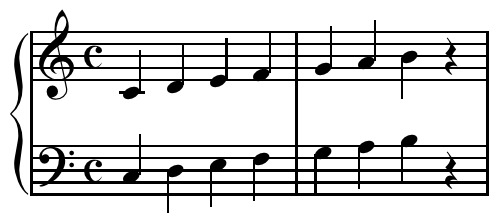
So with that in mind, let me try and give a better explanation of the why of Western music notation.
In contrast to 'piano roll' style notation where you represent every possible note in an absolute way, here each line of the stave (staff if you're American) represents a scale degree of a diatonic scale. The key signature locates you in a particular scale, and all the notes that aren't on that scale are omitted for compactness (since space is at an absolute premium when you have to turn pages during a performance!). If you're doing something funky and including a note outside the scale, well that's a special case and you give it a special-case symbol.
It's a similar principle to file compression: if things are as-expected, you omit them. If things are surprising, you have to put something there.
However, unlike the 简谱 jiǎnpǔ system which I've been learning in my erhu lessons, it's not a free-floating system which can attach to any scale. Instead, with a given clef, each line and space of the stave has one of three possible notes it could represent. This works, because - as we'll discuss momentarily - the diatonic scales can all be related to each other by shifting certain scale degrees up or down in semitones. So by indicating which scale degrees need to be shifted, you can lock in to any diatonic scale. Naisuu.
This approach, which lightly links positions to specific notes, keeps things reasonably simple for performers to remember. In theory, the system of key signatures helps keep things organised, without requiring significant thought while performing.
That is why have to arbitrarily pick a certain scale to be the 'default'; in this case, history has chosen C major/A minor. From that point, we can construct the rest of the diatonic scales as key signatures using a cute mathematical construct called the 'circle of fifths'.
How key signatures work (that damn circle)
So, let's say you have a diatonic major scale. In piano roll style notation, this looks like (taking C as our base note)...

And on the big sheet of scales, like this:

Now, let's write another diatonic major scale, a fifth up from the first. This is called transposition. For example, we could transpose from C major to G major.

Thanks to octave equivalency, we can wrap these notes back into the same octave as our original scale. (In other words, we've added 7 semitones to every note in our original scale, and then taken each one modulo 12 semitones.) Here, I duplicate the pattern down an octave.

Now, if we look at what notes we have in both scales, over the range of the original major scale.

Well, they're almost exactly the same... but the fourth note (scale degree) is shifted up by one semitone.
In fact, we've seen this set of notes before - it is after all nothing more than a cyclic permutation of the major scale. We've landed on the 'Lydian mode', one of the seven 'modes' of the diatonic major scale we discussed in previous posts. We've just found out that the Lydian mode has the same notes as a major scale starting a fifth higher. In general, whether we think of it as a 'mode' or as a 'different major scale' is a matter of where we start (the base note). I'm going to have more to say about modes in a little bit.
With this trick in mind, we produce a series of major scales starting a fifth higher each time. It just so happens that, since the fifth is 7 semitones, which is coprime with the 12 semitones of 12TET, this procedure will lead us through every single possible starting note in 12TET (up to octave equivalency).
So, each time we go up a fifth, we add a sharp on the fourth degree of the previous scale. This means that every single major scale in 12TET can be identified by a unique set of sharps. Once you have gone up 12 fifths, you end up with the original set of notes.
This leads us to a cute diagram called the "circle of fifths".
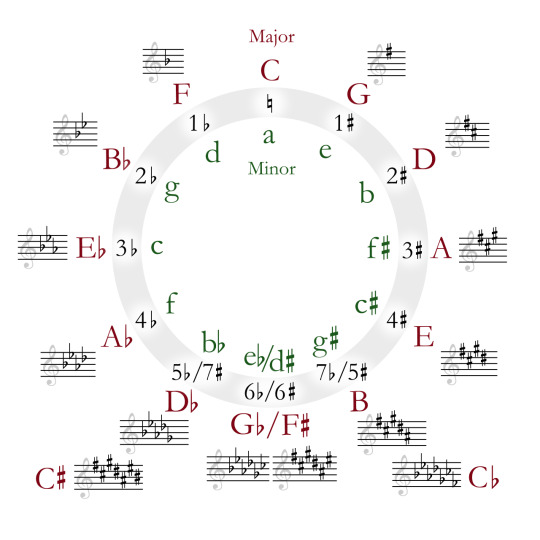
Because going up a fifth is octave-equivalent to going down a fourth, we can also look back one step on the circle to find out which note needs to be made sharper. So, from C major to G major, we have to sharpen F - the previous note on the circle from C. From G major to D major, we have to sharpen C. From D major to A major, we have to sharpen G. And so on.
By convention, when we write a key signature to define the particular scale we're using, we write the sharps out in circle-of-fifths order like this. The point of this is to make it easy to tell at a glance what scale you're in... assuming you know the scales already, anyway. This is another place where the aim of the notation scheme is for a compact representation for performers rather than something that makes the logical structure evident to beginners.
Also by convention, key signatures don't include the other octaves of each note. So if F is sharp in your key signature, then every F is sharp, not just the one we've written on the stave.
This makes it less noisy, but it does mean you don't have a convenient visual reminder that the other Fs are also sharp. We could imagine an alternative approach where we include the sharps for every visible note, e.g. if we duplicate every sharp down an octave for C♯ major...
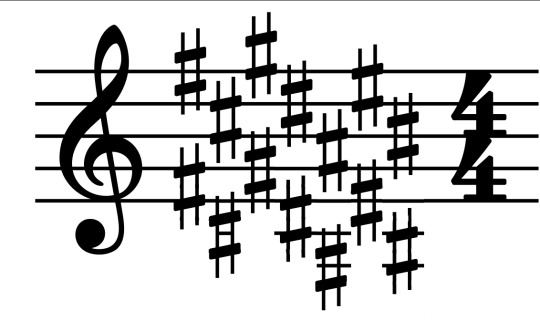
...but maybe it's evident why this would probably be more confusing than helpful!
So, our procedure returns the major scales in order of increasing sharps. Eventually you have added seven sharps, meaning every scale degree of the original starting scale (in this case, C Major) is sharpened.
What would it mean to keep going past this point? Let's hop in after F♯ Major, at the bottom of the Circle of Fifths; next you would go to C♯ Major by sharpening B. So far so good. At this point we have sharps everywhere, so the notes in your scale go... C♯ D♯ E♯ F♯ G♯ A♯ B♯ C♯ ...except that E♯ is the same as F, and B♯ is the same as C, so we could write that as C♯ D♯ F F♯ G♯ A♯ C C♯
But then to get to 'G♯ Major', you would need to sharpen... F♯? That's not on the original C-major scale we started with ! You could say, well, essentially this adds up to two sharps on F, so it's like F♯♯, taking you to G. So now you have...
G♯ A♯ C C♯ D♯ F G G♯
...and the line of the stave that you would normally use for F now represents a G. You could carry on in this way, eventually landing all the way back at the original set of notes in C Major (bold showing the note that just got sharpened in each case):
D♯ F G G♯ A♯ C D D♯ A♯ C D D♯ F G A A♯ F G A A♯ C D E F C D E F G A B C
But that sounds super confusing - how would you even represent the double sharps on the key signature? It would break the convention that each line of the stave can only represent three possible notes. Luckily there's a way out. We can work backwards, going around the circle the other way and flattening notes. This will hit the exact same scales in the opposite order, but we think of their relation to the 'base' scale differently.
So, let's try starting with the major scale and going down a fifth. We could reason about this algebraically to work out that sharpening the fourth while you go up means flattening the seventh when you go down... but I can also just put another animation. I like animations.

So: you flatten the seventh scale degree in order to go down a fifth in major scales. By iterating this process, we can go back around the circle of fifths. For whatever reason, going down this way we use flats instead of sharps in the names of the scale. So instead of A♯ major we call it B♭ major. Same notes in the same order, but we think of it as down a rung from F major.
In terms of modes, this shows that the major scale a fifth down from a given root note has the same set of notes as the "mixolydian mode" on the original root note. ...don't worry, you don't gotta memorise this, there is not a test! Rather, the point of mentioning these modes is to underline that whether you're in a major key, minor key, or one of the various other modes is all relative to the note you start on. We'll see in a moment a way to think about modes other than 'cyclic permutation'.
Let's try the same trick on the minor key.

Looks like this time, to go up we need to sharpen the sixth degree, and to go down we need to flatten the second degree. As algebra demands, this gives us the exact same sequence of sharps and flats as the sequence of major scales we derived above. After all, every major scale has a 'relative minor' which can be achieved by cyclically permuting its notes.
Going up a fifth shares the same notes with the 'Dorian mode' of the original base note, and going down a fifth shares the same notes with the 'Phrygian mode'.
Here's a summary of movement around the circle of fifths. The black background indicates the root note of the new scale.

Another angle on modes
In my first two articles, I discussed the modes of the diatonic scale. Leaping straight for the mathematically simplest definition (hi Kolmogorov), I defined the seven 'church modes' as simply being cyclic permutations of the intervals of the major scale. Which they are... but I'm told that's not really how musicians think of them.
Let's grab the chart of modes again. (Here's the link to the spreadsheet).

We can get to these modes by cyclically permuting the others, but we can also get to them by making a small adjustment of one to a few particular scale degrees. When you listen to a piece of music, you're not really doing cyclic permutations - you're building up a feeling for the pattern of notes based on your lifelong experience of hearing music that's composed in this system. So the modes will feel something like 'major until, owo what's this, the seventh is not where I thought it would be'.
Since the majority of music is composed using major and minor modes, it's useful therefore to look at the 'deltas' relative to these particular modes.
To begin with, what's the difference between major and minor? To go from major to natural minor, you shift the third, sixth and seventh scale degrees down by one semitone.

So those are our two starting points. For the others, I'm going to be consulting the most reliable music theory source (some guy on youtube) to give suggestions of the emotional connotations these can bring. The Greek names are not important, but I am trying to build a toolbox of elements here, so we can try our hand at composition. So!
The "Dorian mode" is like the natural minor, but the sixth is back up a semitone. It's described as a versatile mode which can be mysterious, heroic or playful. I guess that kinda makes sense, it's like in between the major and minor?

The "Phrygian mode" is natural minor but you also lower the 2nd - basically put everything as low as you can go within the diatonic modes. It is described as bestowing an ominous, threatening feeling.

The "Lydian mode" is like the major scale, but you shift the fourth up a semitone, landing on the infamous tritone. It is described as... uh well actually the guy doesn't really give a nice soundbitey description of what this mode sounds like, besides 'the brighest' of the seven, this video's kinda more generally about composition, whatever. But generally it's pretty big and upbeat I think.

The "Mixolydian" mode is the major, but with the seventh down a semitone. So it's like... a teeny little bit minor. It's described as goofy and lighthearted.

We've already covered the Aeolian/Natural Minor, so that leaves only the "Locrian". This one's kinda the opposite of the Lydian: just about everything in the major scale is flattened a bit. Even from the minor it flattens two things, and gives you lots of dissonance. This one is described as stereotypically spooky, but not necessarily. "One of the least useful", oof.

Having run along the catalogue, we may notice something interesting. In each case, we always either only sharpen notes, or only flatten notes relative to the major and minor scales. All those little lines are parallel.
Indeed, it turns out that each scale degree has one of two positions it can occupy. We can sort the diatonic modes according to whether those degrees are in the 'sharp' or 'flat' position.

This is I believe the 'brightness' mentioned above, and I suppose it's sort of like 'majorness'. So perhaps we can think of modes as sliding gradually from the ultra-minor to the infra-major? I need to experiment and find out.
What have we learned...?
Scale degrees are a big deal! The focus of all this has been looking at how different collections of notes relate to each other. We sort our notes into little sets and sequences, and we compare the sets by looking at 'equivalent' positions in some other set.
Which actually leads really naturally into the subject of chord progressions.
So, musical structure. A piece of tonal music as a whole has a "palette" which is the scale - but within that, specific sections of that piece of music will pick a smaller subset of the scale, or something related to the scale, to harmonise.
The way this goes is typically like this: you have some instruments that are playing chords, which gives the overall sort of harmonic 'context', and you have a single-voiced melody or lead line, which stands out from the rest, often with more complex rhythms. This latter part is typically what you would hum or sing if you're asked 'how a song goes'. Within that melody, the notes at any given point are chosen to harmonise with the chords being played at the same time.
The way this is often notated is to write the melody line on the stave, and to write the names of chords above the stave. This may indicate that another hand or another instrument should play those chords - or it may just be an indication for someone analysing the piece which chord is providing the notes for a given section.
So, you typically have a sequence of chords for a piece of music. This is known as a chord progression. There are various analytical tools for cracking open chord progressions, and while I can't hope to carry out a full survey, let me see if I can at least figure out my basic waypoints.
Firstly, there are the chords constructed directly from scales - the 'triad' chords, on top of which can be piled yet more bonus intervals like sevenths and ninths. Starting from a scale, and taking any given scale degree as the root note, you can construct a chord by taking every other subsequent note.
So, the major scale interval pattern goes 2 2 1 2 2 2 1. We can add these up two at a time, starting from each position, to get the chords. For each scale degree we therefore get the following intervals relative to the base note of the chord...
I. 0 4 7 - major
ii. 0 3 7 - minor
iii. 0 3 7 - minor
IV. 0 4 7 - major
V. 0 4 7 - major
vi. 0 3 7 - minor
viiᵒ. 0 3 6 - diminished
Now hold on a minute, where'd those fuckin Roman numerals come from? I mentioned this briefly in the first post, but this is Roman numeral analysis, which is used to talk about chord progressions in a scale-independent way.
Here, a capital Roman numeral represents a major triad; a lowercase Roman numeral represents a minor triad; a superscript 'o' represents a dimished triad (minor but you lower the fifth down to the tritone); a superscript '+' represents an augmented triad (major but you boost the fifth up to the major sixth).
So while regular chord notation starts with the pitch of the base note, the Roman numeral notation starts with a scale degree. This way you can recognise the 'same' chord progression in songs that are in quite different keys.
OK, let's do the same for the minor scale... 2 1 2 2 1 2 2. Again, adding them up two at a time...
i. 0 3 7 - minor
iiᵒ. 0 3 6 - diminished
III. 0 4 7 - major
iv. 0 3 7 - minor
v. 0 3 4 - minor
VI. 0 4 7 - major
VII. 0 4 7 - major
Would you look at that, it's a cyclic permutation of the major scale. Shocker.
So, both scales have three major chords, three minor chords and a diminished chord in them. The significance of each of these positions will have to be left to another day though.
What does it mean to progress?
So, you play a chord, and then you play another chord. One or more of the voices in the chord change. Repeat. That's all a chord progression is.
You can think of a chord progression as three (or more) melodies played as once. Only, there is an ambiguity here.
Let's say, idk, I threw together this series of chords, it ended up sounding like it would be something you'd hear in an old JRPG dungeon, though maybe that's just 'cos it's midi lmao...
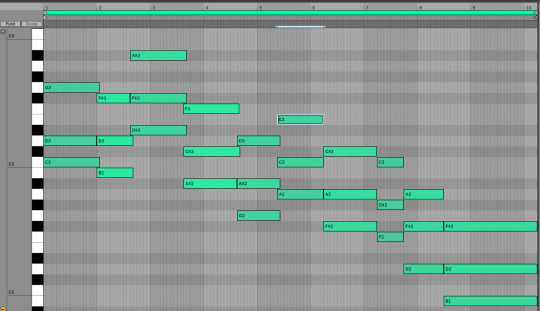
I emphasise at this point that I have no idea what I'm doing, I'm just pushing notes around until they sound good to me. Maybe I would know how to make them sound better if I knew more music theory! But also at some point you gotta stop theorising and try writing music.
So this chord progression ended up consisting of...
Csus2 - Bm - D♯m - A♯m - Gm - Am - F♯m - Fm - D - Bm
Or, sorted into alphabetical order, I used...
Am, A♯m, Bm, Csus2, D, D♯m, Fm, F♯m, Gm
Is that too many minor chords? idk! Should all of these technically be counted as part of the 'progression' instead of transitional bits that don't count? I also dk! Maybe I'll find out soon.
I did not even try to stick to a scale on this, and accordingly I'm hitting just about every semitone at some point lmao. Since I end on a B minor chord, we might guess that the key ought to be B minor? In that case, we can consult the circle of fifths and determine that F and C would be sharp. This gives the following chords:
Bm, C♯dim, D, Em, F♯m, G, A
As an additional check, the notes in the scale:
B, C♯, D, E, F, G♯, A
Well, uh. I used. Some of those? Would it sound better if I stuck to the 'scale-derived' chords? Know the rules before you break them and all that. Well, we can try it actually. I can map each chord in the original to the corresponding chord in B minor.
This version definitely sounds 'cleaner', but it's also... less tense I feel like. The more dissonant choices in the first one made it 'spicier'. Still, it's interesting to hear the comparison! Maybe I could reintroduce the suspended chord and some other stuff and get a bit of 'best of both worlds'? But honestly I'm pretty happy with the first version. I suppose the real question would be which one would be easier to fit a lead over...
Anyway, for the sake of argument, suppose you wanted to divide this into three melodies. One way to do it would be to slice it into low, central and high parts. These would respectively go...
Since these chords mostly move around in parallel, they all have roughly the same shape. But equally you could pick out three totally different pathways through this. You could have a part that just jumps to the nearest note it can (until the end where there wasn't an obvious place to go so I decided to dive)...
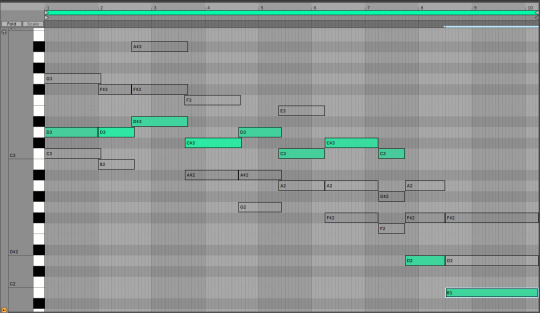
Those successive relationships between notes also exist in this track. Indeed, when two successive chords share a note, it's a whole thing (read: it gets mentioned sometimes in music theory videos). You could draw all sorts of crazy lines through the notes here if you wanted.
Nevertheless, the effects of movements between chords come in part from these relationships between successive notes. This can give the feeling of chords going 'up' or 'down', depending on which parts go up and which parts go down.
I think at this point this post is long enough that trying to get into the nitty gritty of what possible movements can exist between chords would be a bit of a step too far, and also I'm yawning a lot but I want to get the post out the door, so I let's wrap things up here. Next time: we'll continue our chord research and try and figure out how to use that Roman numeral notation. Like, taking a particular Roman numeral chord progression and see what we can build with it.
Hope this has been interesting! I'm super grateful for the warm reception the last two articles got, and while I'm getting much further from the islands of 'stuff I can speak about with confidence', fingers crossed the process of learning is also interesting...
66 notes
·
View notes
Text
youtube
Analogue Affection 01 – Part 1 of a short series of love-notes written in grainy synths and soft glitches. Most of the sounds are from Arturia V collection and sampled microfreak, jupiter. Sequenced in ableton live.
5 notes
·
View notes
Note
im sure you get some variation of this message from time to time but from the bottom of my heart i cannot even begin to express how grateful i am to have discovered you & your music.
i scream cry into my pillow while listening to impossible light- more than im proud to admit but nothing else has captured the raw & vast emotions existing as a mentally ill transsexual to the same degree. i think your noise & sound design style is deeply moving & inspiring as someone who still feels fairly new to audio art & live preforming.
So wanted to ask what yr favorite piece of hardware for preforming has been over the years?
((currently on a quest to find either a pad based midi controller or synth/sampler combo that i can to trigger/gate other gear or add noisey one shots throughout a set the sp404 & digitakt have been a good combo for this but curious if you had any suggestions or thoughts))
cheers ❣️
thankyou for this deeply moving comment! <3 <3 Live, I use mostly laptops with an APC MKII to do many things. However I have been using my Monome Grid 128 both live and to record the cut-up noise sections (i.e. in weaponised dysphoria, a puzzle, please don't leave me, most of the sky may be) since around 2018. It's just used as a 128-note, no-velocity MIDI controller, but I designed specific cut-up instrument racks in ableton to create the KRSSH BRR sound. The knobs on the APC is used to modulate it (microloop timing, beat repeat, lopass etc). There's a lot of randomisation and LFOs to make sure there's minimal repetition and to make it sound more organic.
9 notes
·
View notes
Text
Here's my apocalyptic take on the beat generation. It's a cover of an old Rod McKuen song; I've changed the lyrics a little. I'm still working my way through the Ableton tutorials, so it might sound halfway professional someday—not today, though.
I like this one a lot. Lyrics, and a link to the original, below the cut.
I looked over the mountain and saw a lamb insane With seven eyes and seven horns and tongues of writhing flame The same old ancient story The same old ancient song The central holy fact is that the weak should fear the strong
Come alive in the regeneration brand new body and a troubled new mind Come alive in the regeneration, and everything is gonna be fine!
I cannot hear the music I cannot stand the smell As little baby's little souls fall screaming down to hell It does not have a moral It's never ever fair When babies cry forevermore while angels darn the air
Come apart in the degeneration soul on fire with a troubled new mind Come apart in the degeneration, and everything is gonna be fine!
a crowd came to the mountain it seemed to be the place they saw a stranger standing there, a mask upon his face The softness of a serpent The wisdom of a dove enthralled with holy terror at this great unholy love
And people fall like pebbles And people rise like smoke forever up to heaven like some great eternal joke The punchline leaves you gasping The rhythm's out of joint With God of this you can be sure the cruelty's the point
Come alive in the regeneration brand new body and a troubled new mind Come alive in the regeneration, and everything is gonna be fine!
You wonder what the game is it can't be just for fun As angels build a castle in the center of the sun A million stores deep A million stories tall And that's about the only thing they really dig at all
Burn in hell, call it heat generation brand new body and a troubled new mind Join the band, call it beat generation, and try to hit the right note on time…
Come alive in the regeneration brand new body and a troubled new mind Come alive in the regeneration, and everything's gonna be fine!
Original song: "The Beat Generation" by Bob McFadden and Dor (Rod McKuen--Dor is "Rod" spelled backwards)
#the apocalypse#apocalypse#book of revelation#rod mckuen#bob mcfadden#beat generation#heaven#hell#end of the world#birthday party cheesecake jellybean BOOM#music#mine.txt#mine.jpg#mine.mp3#my art#my music#too bad i don't have an orchestra#or robert quine on guitar...
19 notes
·
View notes
Text
Flash back - Live Looping tribute to 90s / 2000s Racing Games
RESEARCH
My live looping project draws from the audio-visual world of late 90s / early 2000s video games from PS1 and Nintendo 64 – an aesthetic comprised of glossy graphics and postmodern settings, in which the immersive experience is often provided by up-beat, high octane soundtracks. Here are some examples of this:
youtube
youtube
youtube
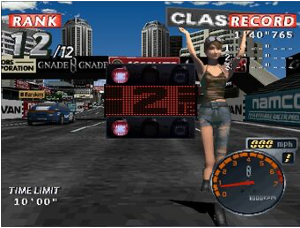

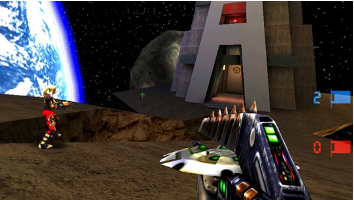
Whilst researching game composers and jungle artists, one of them particularly stood out to me – Hideki Okugawa, the composer responsible for the soundtrack to all 3 Street Fighters. Here are a couple examples of his work.
youtube
youtube
I admire the intensity that Okugawa manages to capture through all his work, nevertheless, I’d like to allow for some contrasting laid-back sections to better match the ambience that I’m after. After some online research on forums, and speaking to my peers, I created a playlist of various tracks that would correspond to this aesthetic.
One of these songs is View of Life by Moonchild, which perfectly captures the nostalgic essence of old video games. The intro section lasts for just over a minute; this adds to the tension and sense of anticipation that one might experience whilst playing a high adrenalin first person shooter or racing game. I have created a mood board to display the desired tone of the project.
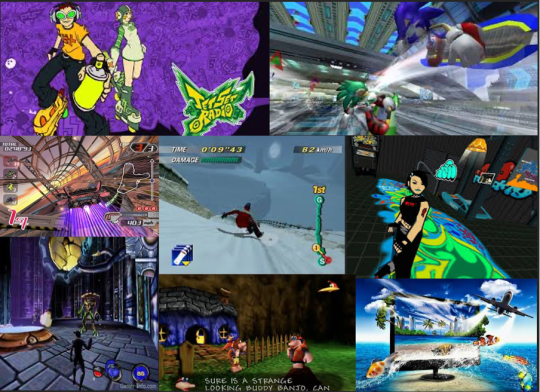
As much as this project is a tribute to 90s/2000s classic video games, I also wish to convey a sense of nostalgia.
Another inspiration behind this project was seeing an Instagram user create a live loop to the same aesthetic:
instagram
The style is slightly different, but it reinforces the notion that this genre has become a trend.
PROTOTYPE & REHEARSALS
In the prototype phase of this project, I made the first version of the track, which was a lot slower, and less energetic. After having delved into breakbeats and jungle, I was drawn to higher tempos, and a slightly different sound pallet.
(google drive link)
I increased the tempo from 125 to 165 and created a new intro (inspired by the aforementioned ‘View of Life’ by ‘Moonchild’). After this I focused on highlighting melodies, rhythms and textures that would be interesting to loop whilst carrying that adrenalin fuelled, ‘racing’ narrative.
Once the arrangement had been completed, I ordered the different audio and midi regions into separate sections; these sections would then become scenes once imported into Ableton. I divided them into 10 sections (some of them repeating), before stemming each track into one of seven folders (one for each scene). I then imported them making sure to de-select warp on each track. I have added sped up screen recordings of this process in the OneDrive folder.
Originally, I had planned to play my set in the same way as Elise Trouw in this video:
youtube
She uses arrangement view to input midi notes that she has midi mapped to different functions such as record, stop, playback, loop, etc. This means that those set functions will activate automatically in relation to the timeline. which is useful for handsfree, seamless transitions. Although this is a great technique in some circumstances, it comes at the cost of freedom; I wanted my track to stay structured whilst being able to improvise melody lines and transition to whichever scene suits me in the moment.
The hardware I used to create the set comprised of a Maschine MK3 Mikro, an ableton launchpad, an RD-08 keyboard and a sustain pedal. I used a filter plugin on the stereo out and mapped the cutoff to the Maschine MK3’s fx strip in midi mode. I had originally mapped it to the keyboards modulation wheel, but I found it to be less intuitive. I also mapped the sustain pedal to control the delay feedback on the e-piano.
Should I do this again, I would like to find a way of mapping different parameters to an xbox or ps4 controller, in the spirit of the theme.
I have included a screenshot of my performance to highlight my set-up.
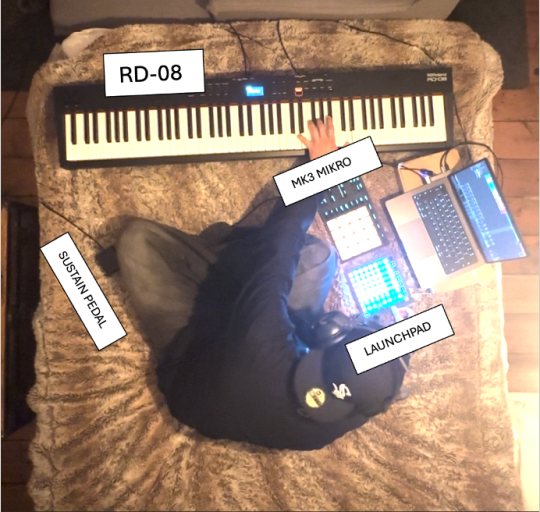
I set up my phone camera on top of a lamp, which worked well regarding the placement but ideally, I would like to find a more secure place to hold it as it fell several times. I would like to keep this camera angle going forwards with this type of content as it showcases the both the hardware and the way it is being used.
FINAL PERFORMANCE AND DOCUMENTATION
The final performance consisted of a one take recording with seven scenes being triggered in different orders, with four midi tracks being controlled by a keyboard and drum pad and used to improvise melodies and chords throughout the performance. The premise was to have slightly different results every take whilst retaining a sense of structure and coherence. As a result, whilst being intelligible for the listener, the piece remains original and interesting every time.
The improvised melodies reflect the motion of a video game, be it the tension of a tactical rpg or a race in a futuristic landscape. This way, the soundtrack becomes the narrative. In order to push the idea of this narrative I structured each new scene to represent a new levels or areas in a game, with the intro ramping up to the chorus, and abrupt transitions mimicking the erraticism found within these landscapes. I made use of real-time triggered effects throughout the performance to further simulate this experience.
I used a birds eye view angle to capture my interactions with the hardware and showcase exactly how the piece was constructed. In the editing of the video, I chose not to include any cuts in an effort to present the set as clearly as possible. I also included a split screen format with a portion of the screen showing gameplay from extreme g racing to make the experience more immersive. This is the final render:
youtube
2 notes
·
View notes
Text

Hello Hello I’m Donnie Pierre!! He/Him
Inbox status: OPEN
Commission status: OPEN
I am an artist; occasional animator and music nerd currently in college for audio production! I love making illustrations in Blender and make album art as a side gig!
This blog is mostly art with the occasional reblog of things I think are cool. If you’re looking for my more spammy account that would be @queen-reblig
My ask box is open; tell me anything silly on your mind and I may just pick up the proverbial phone!
FAQ
What programs do you use?
For animation I like to use Blender: Grease Pencil and Clip Studio Paint. For normal art stuff pretty much those programs as well with the addition of Adobe photoshop and illustrator for editing touches. I do plan on switching fully to the affinity designer suite once my school stops paying for my Adobe subscription.
For making music I used to use ableton live; I now use and prefer FLstudio.
How do you make those 3D illustrations?
I actually plan on making a few blog posts as well as a YouTube video about the process sooner or later. When I do I will be sure to link it right here. I usually do add rambles underneath the cut of a lot of my work if you are interested in my thought process.
What fandoms do you frequent?
While I primarily make art pertaining to the IM fandom I also like:
Sonic the Hedgehog; Parappa the Rapper: Sam & Max Freelance Police; Psychonauts; Mario/Paper Mario; Moomin Valley; Trolls; Rock-a-Fire Explosion; ROTTMNT. I also lurk a lot in the Undertale fandom.
Who are your biggest inspirations?
Big list but I’ll narrow it down to 5
Louie Zong
Johann Banta
Bo En
Lei_Doodles
William Roberts
Are you open to art trades?
At the moment? Yes! It’s summertime so my college schedule is less packed meaning more time for art! I’m experimenting with making some physical goods as well; something along the line of wooden figurines. That’s gonna cost me a little extra money; especially if I ship it to you; so I’ll stick with trading 3D art instead. If you’re interested in a trade let me know!
Side note; I can’t guarantee I’ll say yes to EVERYONE who asks. If I happen to say no please; please don’t take it personally.
Lastly; any cool projects you working on?
Yes actually; I’m currently working on making an AMV to my song You With Me/I’m your Guy. The song itself is unreleased; but it was originally made for my electronic music class final and morphed into its own beast. I’m trying to keep this project as low pressure for myself as possible; and since I have this horrible curse thing where if I talk about doing something too much life decides to throw something horribly life-changing my way I tend not to talk alot about the original things I make. What can I say I’m a boy failure like that.
But yeah the song I made is based off of my whole life pretty much becoming uprooted and flipped on its head last year. Getting thrown headfirst into the adult world is NOT a fun experience I’ll tell you that. And so I wanted to make visuals for it that really honors that feeling of the last threads of true child like naivety falling away.
I’m still really guarded when it comes to sharing the music I make; a habit I hope to break as I start this next degree. But if you’re interested in listening to the song before/if I ever finish that amv I’m sure once I publish my Neocity I’ll have a corner just dedicated to unreleased music for yall to listen to. That or if you really are curious you can ask and I may let you have a listen.
I’ve also added all the tags I use to this post so you can explore different aspects of my work!
✨Links✨
Visit my Neocity: in-progress
Visit my Ko-Fi: Click Here
Visit my Bluesky: Click Here
If you have business inquiries here on tumblr of all places you can DM me and I’ll shoot you my business email.
Thanks for visiting my blog and if you took the time to read this doubly thanks to you! Have a great day/night!
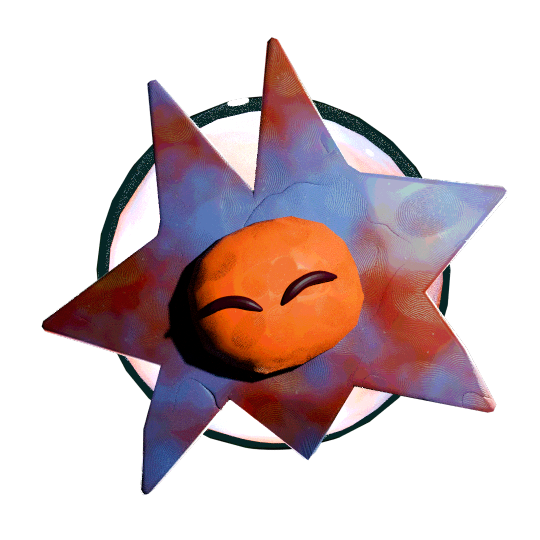
#perri talks#perri requests#perri ocs#perri commission updates#perri's fanfic tag#pierres music playground#perri blender art tag#perri answers
2 notes
·
View notes
Text
So scareds. I've built this up for 6 years. 6 years ago, I turned my back on that city, on that university, transferred out with regrets but knowing that this would be better. I left in April 2019. Shit, how much time has passed. When I set foot on my new campus in September, I was determined to dislike it, because I didn't like it. It was different. It was small. I had nothing to do. I had to make friends again. I was in the middle of nowhere. All the 'freedom' of moving out to somewhere on your own for the first time was eaten up by the fact that there was nothing to do and no place to do it. I lived a little far away too, which didn't help.
I took so many walks that first semester. Got really into podcasts and just walking, listening to full albums. I still can't put on Poses by Rufus Wainwright without my eyes flooding with memories of October and November walks. Too far from campus to be in the fun, grabbing a dinner alone, listening to a new album. Listening to a new (old) radio podcast from a decade ago. Various comedian things. Determined to just. Idk. Finish up my studies as soon as possible and move back. I didn't like it. I was bored and quite lonely and possibly a bit isolated by how far away I was. I think I got so bored I wrote and rehearsed two whole 20-minute stand up sets. I performed them to friends back home on the phone. A friend and I started a mad podcast. Something, anything to do...
Wanting something more like a podcast I stumbled towards local radio and the campus station I was trying to volunteer with. It was also really dead, I can't lie. We'd have a few touring bands and everyone was in their mid-30s. I was 19 for fuck's sake. I was on the mission every single 19 year old is on: do something significant and cool before you turn the big 2-0. 20 was scary. But what cool stuff was there to do in a bumfuck quiet town that was constraztingly filled with party-loving students? I wasnt a partier.
I was helping out with sorting music submissions to our library (we were still getting physical submissions on CD back in the day). I was to write a short note and a genre for cataloguing, and was allowed to come on the show and describe a few albums I'd reviewed on air, for mic practice.
Here's a 60 year old bluegrass artist who sends you his latest work from walking across the Prairies courtesy of a SOCAN grant. Here's a fiddle band from the Nova Scotia scene sending their latest CD. They're veterans who have worked with Grammy winning producers. Yay. This means nothing to me. This roving folk trubadour has been singing songs of his growing up across the country for the last 40 years. Cheers man. Here's more roots rock... Dude I am so bored. There's nothing happening around here. Where are the young people?? From what I remember from O-week, they made a discord server to share their Ableton beats. They're dancing in the nightclubs to Martin Garrix. Not exactly our station's brand, but largely also not mine.
Fine. Fuck it. It's something to do. I joined a punk show eventually, quite by accident. Just walked into it looking for someone else, ended up staying the hour having hit it off with the host, and she kindly asked me to join her on late-night radio. Ooh! Exciting.
Up until this point, I'd rarely actually been on the airwaves because I always had class just before the previous show I was talking about started. So I was like, nervous nervous. Practising what I'd say, what cool bands I could bring up, brushing up my punk history.
Well, that went on so well I was with her until the pandemic hit. (Which is when my show started, we had dead air since do many people left when the first lockdowns hit that they just gave me an hour to fill with music and talk from home. That's where yellow brit road started anyway.)
Something changed when I came back in 2022. I joined the morning teams the following Jan, by April we had student bands. Summer 2023 was crazy. There were so many people. Locally. It was so much fun. I got so involved with community. The student bands burst onto the scene that fall. I fell in love with the idea of community. There was something here, hidden away, unbeknownst to the rest of the province, something that was ours in a way nothing had been in ages. It was young again. Younger than me now, in fact.
I was meant to finish my degree early and get the fuck out of here. I stayed an extra year. I'm the oldest person in the room. I'm the Elder you ask for advice who's a friend but not really your friend group, they're Older and you like having them around but come on. I fell in love with fitting into something cohesive and whole.
So it's strange now, leaving. Does the place I had hoped the big city was actually hold up? You need to do all that work again to build up that community— and I'm back now as an outsider. It's funny because I started there. But you'd never guess. Even I forget (is that healing?)
I'm just scareds. It's not 1998 anymore. You can just see that the twinkle is gone from many people's eyes. They're tired. Rent used to be 400. It's now $1700. No one has the time. They've gotta commute back to their parents place 2 hours away. They've gotta pick up extra shifts at work. They're just exhausted, bless them they're trying.
Who has the time for leisure? Who has the energy? Who has the money to pay off a fine from innocent rehearsals drawing noise complaints, now that all the rehearsal spaces are shutting down?
Who has the earnesty to stick around this city and scene, when people see opportunities in the arts dwindling and every other band you see coming up alongside you is competition rather than a celebration of your city's talent? Who wants to get locked into little factions that won't talk to each other?
It's killing our arts scenes. Fucking 'entertainment district' in name alone.
I took the tram yesterday and we crossed from the entertainment district into the central financial district. The dead eyes and cleaned up looks are imposing. It's coming for the arts. It's coming for the culture district too. There's no romance left in the city. There's no bohemia, nothing exciting can develop here, only in spite of here.
Is this the wrong time to be leaving? I helped build up what we have in my little town right now. I have a tiny, tiny hand in it. What if this is the breaking point and anyone cool has had enough of the big city? Everyone's leaving because it's quite unliveable. Am I moving into an unliveable place at the worst time possible?
Because I'm sorry— large, international nostalgia acts are not 'a vibrant, thriving culture'. It's the new world underground that's culture. And I see that different from when I was 18, for sure.
When I was 18, I was just so happy to be in a city where the band Muse toured. Now, such a thing would ring hollow. I still travel to see Muse, mind. I've done that a few times. Still, I do acknowledge we have some of the worst crowds. It's the deadness. It breaks my heart. Everyone is just too tired, too caught up in dayjob work and stress. I have no doubt I'll be too.
Ostensibly, I am moving because it is "good for my tech industry career" to be in a big town: more opportunities, more connections and all. Where do you see yourself in 5 years? Not working in this industry at all. It's mad to say but I want to work in culture and the arts. Now that's a mad person talking, so I can't just say that out loud. Who's gonna pay big-city rent then? So I'll join the dead-eyed.
Will I become one of those 'itll surprise you to learn they used to be cool' people who your niblings and kids will discover had the coolest life in college and then just eased into the corporate world and that side was never heard from again. Wistfully ruminated on "what could've been" idly sometimes, but firmly in a past that cannot be revived. "You belong here" goes so far, necessity goes further.
So I hope it's not the beginning of the end. When I try to think about what I can and will do in life... I just don't feel like an adult capable of making decisions when that happens. I have a prettty solid portfolio for jobs that don't exist to the point where I sound like an impractical 6-year-old child that wants to be an astronaut, talking in fantasies, when I talk about actual things I HAVE done in my time.
I don't know!! What's the end goal?!! My trial period on adulthood is coming to an end. There is permanence now. The minute I walk out of this town, I leave behind the flexibiity of studenthood. I leave behind the protections being a dreamer. That's impractical. I now need to face up to my own life and become a serious person. I never noticed the time fly by. I feel wholly unprepared. I just hope I can do it without losing my soul.
#Sigh.#Adulthood#Oh and as is typical of my life that old standup routine?#I was scheduled to perform it at a gig on 26 March 2020 🥰✨#I took it as a sign and never looked back at standup. God the hours I had put into getting an OPEN SPOT.
3 notes
·
View notes
Text
Das Kapital, FL Studio's version
One more sleepless night in this wonderful yet pathetic cell… my bedroom, of course. Some Rap Songs weeps through me with its abstract instrumentals by randomblackdude and this suffering Earl, who once disturbed, then influenced me back when I was heading to school at the age of 11. My second shock after the eternal trauma of Madvillainy. That album reminded me how important it was to have YOUR OWN SOUND (which translated in french goes "SON SON" shoutsout to grandpa Godard for this one). I don’t even remember if I was making music at that time; my lyrics, still in their embryonic stage, were already scribbled down in the notes app of the first phone my mom gave me.
Little Kay was frustrated: the lyrics and the flow were there, but not the voice. Then Thebe, with his effortless voice, decided to show me it was possible (just as Danny Brown, Eazy-E, and even DOOM would later do). I could rap. I could write. I was born for this.
I should probably revisit that frustration because it led me to discover one of life’s greatest joys: composition. It was after my brother showed me a Rhythm Roulette episode (notably the ones with 9th Wonder, Mac Miller, or Oh No) that my love for hip-hop, beyond just listening to it, pushed me to dive into sound creation.
The type beat era—that’s my generation. One of the greatest pitfalls wasn’t using these templates to elevate yourself but staying stuck on the same level, the same floor, as when you started. I understand why those beatmakers are hated so much: they’re at the mercy of mediocre rappers. But is it the fault of those mediocre rappers or the mediocre producers? Probably a bit of both. That’s why I decided to step away from the life of a mere producer. I chose to keep my sounds for myself and for people I consider to be part of the same world, the same reality. I blame those FL or Ableton mascots who pressure me to not sample, to experiment but not too much, all for the sake of profit.
Maybe it’s narcissism; I’m not sure. What I do know is that the idea of erasing my own sounds, my own pain, my own sensitivity—all those hours spent tinkering with software to express my desires—just so some stranger who doesn’t know me, doesn’t respect me, can come along and destroy it all… just no.
My life breathes out through my beats the same way these drums exhale my damn troubles—the ones that make you want to die.
#some rap songs#mf doom#hip hop#art#writers on tumblr#music blog#blog#short story#music#essay#personal essay
2 notes
·
View notes
Text
When I want to eat because I want a dopamine rush do this instead:
Prepare a protein coffee in your favourite cup
Drink a monster/Coke Zero with ice
Eat gum
Sing a song
Dance
Do some ballet stretches
Put on your favourite outfit (gym/ballet/everyday) and go for a walk/gym/stretch
Clean your room
Plan your outfits/style with Pinterest/vinted/websites/wishlist (+ prepare Christmas wishlist)
Go on Pinterest/tiktok/edtok/edumblr/edtube
Read a history book
Prepare your water bottle and drink a lot of it
Do your hair+skincare+outfit
Journal
Learn something new + iPad notes (history, finance, ableton)
Listen to your favourite tracks on Spotify/ TikTok
Go workout
Buy something from your wishlist
Go shopping/try new clothes
Plan your next meals
Watch your favourite shows
Think about your motivations
Learn french
Study fianance
Read a book
Gonna update this as I go on
6 notes
·
View notes
Text
i don't understand how to do note lengths in ableton
2 notes
·
View notes
Text
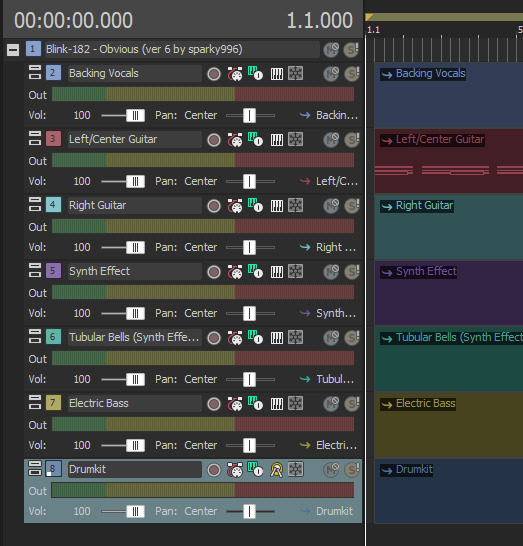



exported a midi file from guitar pro 6, then imported it into the 4 DAWs i have on my computer (ACID Music Studio, Mixcraft, Ableton Live, and MPC Beats) to see how they handled it because i've had some issues with that before.
Interesting things to note:
acid and mpc beats both didn't open the first track. running into this with acid is why i did this quick test. it will import any song markers, tempo, and time signature changes, but will only pull the midi data starting from track 2. the title of track one will also be the title of the .acd file should you save it. whether mpc beats does the same thing or not because of how it handles external midi files or because of a track limit, i'm not sure yet. this was exclusively a test with importing the files themselves.
live and mixcraft both brought in all the files, but mixcraft is the only one so far that doesn't automatically import, at the bare minimum, the tempo and time signature. you have to ope the midi file itself from the browser instead of dragging and dropping.
exporting the midi from guitar pro 6 cuts off any midi that goes across a bar line regardless of length, as shown in the midi file in the picture. want to start on the "and" of a bar? you have to re-extend it yourself in the DAW each time, throughout the whole song. i have no idea if this is fixed in any newer version.
i have not yet tried it on: bespoke synth, puredata, tiny vocaloid editor, or studio one. expect an update if i do.
8 notes
·
View notes